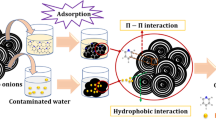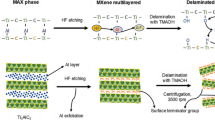Abstract
The increasing threats of oxo-anions in drinking water have posed a serious threat to human health, aquatic environment, ecology, and sustainability. Accordingly, developments of cost-effective and sustainable nanomaterials for water remediation are on top priority and highly sought in global research community. Carbon nano-onions (CNOs) are one of the emerging nanomaterials for water purification because of its unique morphology, surface reactivity, high density of surface-active sites, and microporous structure. Herein, flaxseed oil–derived CNOs are utilized as efficient adsorbent for the removal of toxic oxo-anions. Aside from the green and economic nature, CNOs provide high adsorption efficiency ~ 806.45 mg g−1 for the removal of \({\text{MnO}}_4^-\) (99.9%) from aqueous system at ambient temperature, neutral pH in 70 min. The adsorption of \({\text{MnO}}_4^-\) onto CNOs was well fitted in pseudo-second order kinetics and followed the Langmuir adsorption isotherm model. The adsorption process was determined to be exothermic and spontaneous from the resulting thermodynamic characteristics. Furthermore, the high hydrophobic nature of CNOs make it recycling simpler. The real-life applicability of CNOs towards \({\text{MnO}}_4^-\) removal was tested in tap water, river water, and dam water. With all these observed results, CNOs show promise for practical water remediation applications.
Graphical abstract







Similar content being viewed by others
Data availability
All data and materials reported in the manuscripts are available.
References
Ahlawat J, Masoudi Asil S, Guillama Barroso G, Nurunnabi M, Narayan M (2021) Application of carbon nano onions in the biomedical field recent advances and challenges. Biomater Sci 9:626–644
Al-Aoh HAJDWT (2019) Equilibrium, thermodynamic and kinetic study for potassium permanganate adsorption by Neem leaves powder. Desalin Water Treat 170:101–110
Al-Hashimi O, Hashim K, Loffill E, Marolt Čebašek T, Nakouti I, Faisal AA, Al-Ansari NJM (2021) A comprehensive review for groundwater contamination and remediation: occurrence, migration and adsorption modelling 26, 5913
Alamrani NA, Al-Aoh HA (2021) Elimination of Congo red dye from industrial wastewater using Teucrium polium L. as a low-cost local adsorbent. Adsorp Sci Technol 2021:5728696
Bani-Atta SA (2022) Potassium permanganate dye removal from synthetic wastewater using a novel, low-cost adsorbent, modified from the powder of Foeniculum vulgare seeds. Sci Rep 12(1):4547
Chatterjee S, Qin J, Li X, Liang F, Rai DK, Yang Y-WJJoMCB (2020) Safranin O-functionalized cuboid mesoporous silica material for fluorescent sensing and adsorption of permanganate. J Mater Chem B 8:2238–2249
Czepirski L, Balys MR, Komorowska-Czepirska EJIJoC (2000) Some generalization of Langmuir adsorption isotherm. Internet J Chem 3:1099–8292
Das GS, Sarkar S, Aggarwal R, Sonkar SK, Park J-W, Tripathi KM, Kim T (2019) Fluorescent microspheres of zinc 1,2-dicarbomethoxy-1,2-dithiolate complex decorated with carbon nanotubes. Carbon Lett 29(6):595–603
Deng S-Q, Mo X-J, Zheng S-R, Jin X, Gao Y, Cai S-L, Fan J, Zhang W-GJIc (2019) Hydrolytically stable nanotubular cationic metal–organicframework for rapid and efficient removal of toxic oxo-anions and dyes from water. Inorg Chem 58:2899–2909
Dhiman N, Ghosh S, Mishra YK, Tripathi KM (2022) Prospects of nano-carbons as emerging catalysts for enzyme-mimetic applications. Mater Adv 3(7):3101–3122
Dias EM, Petit C (2015) Towards the use of metal–organic frameworks for water reuse: a review of the recent advances in the field of organic pollutants removal and degradation and the next steps in the field. J Mater Chem 3:22484–22506
Garg R, Garg R, Khan MA, Bansal M, Garg VK (2022) Utilization of biosynthesized silica-supported iron oxide nanocomposites for the adsorptive removal of heavy metal ions from aqueous solutions. Environ Sci Pollut Res 1–14
Gunture J, Kaushik AK, Garg D, Saini PK, Sonkar SK (2020) Pollutant diesel soot derived onion-like nanocarbons for the adsorption of organic dyes and environmental assessment of treated wastewater. Ind Eng Chem Res 59(26):12065–12074
Guo A, Bao K, Sang S, Zhang X, Shao B, Zhang C, Wang Y, Cui F, Yang X (2021) Soft chemistry synthesis, solubility and interlayer spacing of carbon nano-onions. RSC Adv 11:6850–6858
Hashim KS, Ewadh HM, Muhsin AA, Zubaidi SL, Kot P, Muradov M, Aljefery M, Al-Khaddar RJWS (2021) Phosphate removal from water using bottom ash: Adsorption performance, coexisting anions and modelling studies. Water Sci Technol 83:77–89
Jung S, Myung Y, Das GS, Bhatnagar A, Park J-W, Tripathi KM, Kim T (2020) Carbon nano-onions from waste oil for application in energy storage devices. New J Chem 44(18):7369–7375
Keyvani F, Rahpeima S, Javanbakht V (2018) Synthesis of EDTA-modified magnetic activated carbon nanocomposite for removal of permanganate from aqueous solutions. Solid State Sci 83:31–42
Kumar A, Kumar V, Kumar M, Awasthi KJPC (2018) Synthesis and characterization of hybrid PANI/MWCNT nanocomposites for EMI applications. Polym Compos 39(11):3858–3868
Kumar S, Liu S, Mohan B, Zhang M, Tao Z, Wan Z, You H, Sun F, Li M, Ren P (2021) Fluorine-containing triazole-decorated silver(I)-based cationic metal–organic framework for separating organic dyes and removing oxoanions from water. Norg Chem 60(10):7070–7081
Kumari P, Tripathi KM, Jangir LK, Gupta R, Awasthi K (2021) Recent advances in application of the graphene-based membrane for water purification. Mater Today Chem 22:100597
Laddha H, Yadav P, Agarwal M, Gupta RJES, Research P (2022) Quick and hassle-free smartphone’s RGB-based color to photocatalytic degradation rate assessment of malachite green dye in water by fluorescent Zr–N–S co-doped carbon dots. Environ Sci Pollut Res 1–12
Mahmoud ME, Yakout AA, Saad SR, Osman MM (2016) Removal of potassium permanganate from water by modified carbonaceous materials. Desalin Water Treat 57(33):15559–15569
Mishra S, Singh AK, Singh JK (2020) Ferrous sulfide and carboxyl-functionalized ferroferric oxide incorporated PVDF-based nanocomposite membranes for simultaneous removal of highly toxic heavy-metal ions from industrial ground water. J Membr Sci 593:117422
Mohapatra D, Dhakal G, Sayed MS, Subramanya B, Shim J-J, Parida S (2019) Sulfur doping: unique strategy to improve the supercapacitive performance of carbon nano-onions. ACS Appl Mater Interfaces 11(8):8040–8050
Mykhailiv O, Zubyk H, Plonska-Brzezinska ME (2017) Carbon nano-onions: unique carbon nanostructures with fascinating properties and their potential applications. Inorg Chim Acta 468:49–66
Pakhira B, Ghosh M, Allam A, Sarkar S (2016) Carbon nano onions cross the blood brain barrier. RSC Adv 6(35):29779–29782
Park SJ, Das GS, Schütt F, Adelung R, Mishra YK, Tripathi KM, Kim T (2019) Visible-light photocatalysis by carbon-nano-onion-functionalized ZnO tetrapods: degradation of 2,4-dinitrophenol and a plant-model-based ecological assessment. NPG Asia Materials 11(1):8
Pincus LN, Rudel HE, Petrović PV, Gupta S, Westerhoff P, Muhich CL, Zimmerman JB (2020) Exploring the mechanisms of selectivity for environmentally significant oxo anion removal during water treatment: a review of common competing oxo-anions and tools for quantifying selective adsorption. Environ Sci Technol 54:9769–9790
Rahpeima S, Javanbakht V, Esmaili J (2018) Synthesis and characterization of activated carbon/maghemite/starch magnetic bionanocomposite and its application for permanganate removal from aqueous solution. J Inorg Organomet Polym Mater 28(1):195–211
Rani S, Aggarwal M, Kumar M, Sharma S, Kumar D (2016) Removal of methylene blue and rhodamine B from water by zirconium oxide/graphene. Water Sci 30:51–60
Regulska E, Olejnik P, Zubyk H, Czyrko-Horczak J, Chaur MN, Tomczykowa M, Butsyk O, Brzezinski K, Echegoyen L, Plonska-Brzezinska MEJRA (2020) Nanostructural catalyst: metallophthalocyanine and carbon nano-onion with enhanced visible-light photocatalytic activity towards organic pollutants. RSC Adv 10(18):10910–10920
Saghanejhad Tehrani M, Zare-Dorabei R (2016) Highly efficient simultaneous ultrasonic assisted adsorption of methylene blue and rhodamine B onto metal organic framework MIL-68(Al): central composite design optimization. RSC Adv 6:27416–27425
Sakulthaew C, Chokejaroenrat C, Poapolathep A, Satapanajaru T, Poapolathep S (2017) Hexavalent chromium adsorption from aqueous solution using carbon nano-onions (CNOs). Chemosphere 184:1168–1174
Sen A, Dutta S, Dam GK, Samanta P, Let S, Sharma S, Shirolkar MM, Ghosh SK (2021) Imidazolium-functionalized chemically robust ionic porous organic polymers (iPOPs) toward toxic oxo-pollutants capture from water. Chemistry 27(53):13442–13449
Sharma M, Chaudhary K, Kumari M, Yadav P, Sachdev K, Chandra Janu V, Gupta R (2020) Highly efficient, economic, and recyclable glutathione decorated magnetically separable nanocomposite for uranium(VI) adsorption from aqueous solution. Mater Today Chem 18:100379
Sharma M, Laddha H, Yadav P, Jain Y, Sachdev K, Janu VC, Gupta R (2022a) Selective removal of uranium from an aqueous solution of mixed radionuclides of uranium, cesium, and strontium via a viable recyclable GO@chitosan based magnetic nanocomposite Mater Today Commun 32:104020
Sharma P, Laddha H, Agarwal M, Gupta R (2022b) Selective and effective adsorption of malachite green and methylene blue on a non-toxic, biodegradable, and reusable fenugreek galactomannan gum coupled MnO2 mesoporous hydrogel. Microporous and Mesoporous Mater 338:111982
Shukla S, Khan I, Bajpai VK, Lee H, Kim T, Upadhyay A, Huh YS, Han Y-K, Tripathi KM (2019) Sustainable graphene aerogel as an ecofriendly cell growth promoter and highly efficient adsorbent for histamine from red wine. ACS Appl Mater Interfaces 11(20):18165–18177
Sonkar SK, Roy M, Babar DG, Sarkar S (2012) Water soluble carbon nano-onions from wood wool as growth promoters for gram plants. Nanoscale 4(24):7670–7675
Tripathi KM, Bhati A, Singh A, Gupta NR, Verma S, Sarkar S, Sonkar SK (2016a) From the traditional way of pyrolysis to tunable photoluminescent water soluble carbon nano-onions for cell imaging and selective sensing of glucose. RSC Adv 6(44):37319–37329
Tripathi KM, Singh A, Bhati A, Sarkar S, Sonkar SK (2016b) Sustainable Feasibility of the environmental pollutant soot to few-layer photoluminescent graphene nanosheets for multifunctional applications. ACS Sustain Chem Eng 4(12):6399–6408
Tripathi KM, Sonker AK, Bhati A, Bhuyan J, Singh A, Singh A, Sarkar S, Sonkar SK (2016c) Large-scale synthesis of soluble graphitic hollow carbon nanorods with tunable photoluminescence for the selective fluorescent detection of DNA. New J Chem 40(2):1571–1579
Tripathi KM, Bhati A, Singh A, Sonker AK, Sarkar S, Sonkar SK (2017) Sustainable changes in the contents of metallic micronutrients in first generation gram seeds imposed by carbon nano-onions: life cycle seed to seed study. ACS Sustain Chem Eng 5(4):2906–2916
Tyagi A, Tripathi KM, Gupta RK (2015) Recent progress in micro-scale energy storage devices and future aspects. J Mater Chem A 3(45):22507–22541
Verma RK, Kapoor R, Gupta SK, Chaudhari RRJPCJ (2014) An efficient technique for removal of K+ and MnO4− ions through adsorption in aqueous solution by using activated charcoal. Pharm Chem J 1:20–25
Yang J, Zhang Y, Kim DY (2016) Electrochemical sensing performance of nanodiamond-derived carbon nano-onions: comparison with multiwalled carbon nanotubes, graphite nanoflakes, and glassy carbon. Carbon 98:74–82
Yang J, Shojaei S, Shojaei S (2022) Removal of drug and dye from aqueous solutions by graphene oxide: adsorption studies and chemometrics methods. npj Clean Water 5:5
Zhang Q, Cheng Y, Fang C, Shi J, Han H, Li M, Zhao J (2022) Electrochemically enhanced adsorption of organic dyes from aqueous using a freestanding metal–organic frameworks/cellulose-derived porous monolithic carbon foam. Biores Technol 347:126424
Zhao X, Yu X, Wang X, Lai S, Sun Y, Yang D (2021) Recent advances in metal-organic frameworks for the removal of heavy metal oxoanions from water. Chem Eng J 407:127221
Acknowledgements
The authors are thankful to MRC, MNIT, Jaipur, for characterization facilities and IUAC, New Delhi, for the financial support [UFR 56321].
Funding
IUAC, New Delhi, for the financial support [UFR 56321].
Author information
Authors and Affiliations
Contributions
All authors have contributed to the study conception and design. Poonam Kumari: Material preparation, data collection, and analysis. Kumud Malika Tripathi: Formal analysis, editing manuscript. Ragini Gupta: Supervision, conceptualization, and editing. Kamlendra Awasthi: Conceptualization and supervision. All authors read and approved the final manuscript.
Corresponding author
Ethics declarations
Ethical approval
N/A.
Consent to participate
Authors have given their consent to publish the manuscript.
Consent to publish
All authors have approved the manuscript for publication.
Competing interests
The authors declare no competing interests.
Additional information
Responsible Editor: Tito Roberto Cadaval Jr
Publisher's note
Springer Nature remains neutral with regard to jurisdictional claims in published maps and institutional affiliations.
Rights and permissions
Springer Nature or its licensor holds exclusive rights to this article under a publishing agreement with the author(s) or other rightsholder(s); author self-archiving of the accepted manuscript version of this article is solely governed by the terms of such publishing agreement and applicable law.
About this article
Cite this article
Kumari, P., Tripathi, K.M., Awasthi, K. et al. Sustainable carbon nano-onions as an adsorbent for the efficient removal of oxo-anions. Environ Sci Pollut Res 30, 15480–15489 (2023). https://doi.org/10.1007/s11356-022-22883-3
Received:
Accepted:
Published:
Issue Date:
DOI: https://doi.org/10.1007/s11356-022-22883-3




